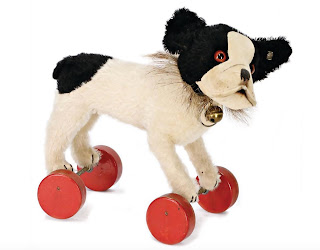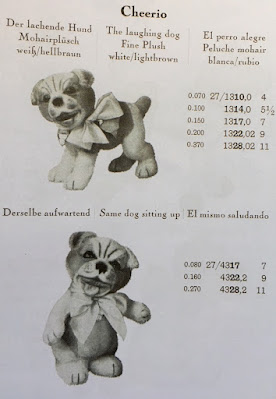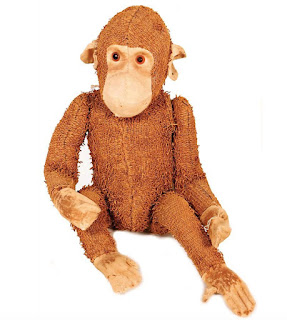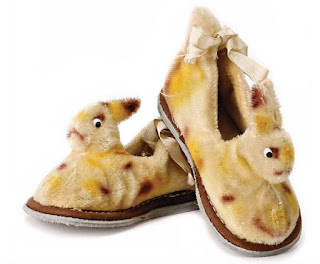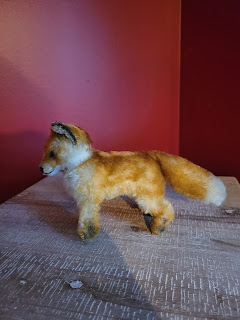Dog-gonnit! The blue ribbon temptations are endless at the Ladenburger Spielzeugauktion GmbH Special Steiff Auction on November 6th! This can't miss event features over 350 simply awesome button-in-ear goodies. The catalog reads like a "who's who" in the vintage Steiff world. Steiffgal recently offered her top Teddy Baby and "one-derfuls" top picks from this sale; now here are her canine cutie favorites.
This first pick is the wheel deal indeed. This is lot #4179, a standing Bully the Bulldog on wheels. The cataloging reads, "Bully, on excenter-wheels, black/beige mohair, velvet insert in very good condition, very nice colouring at the snout, with button, long stretched F, minimally rests of the white color, with paper breast sign with metal edge, produced around 1930, length: 23 cm, height: 22 cm, very expressive, except of minimally places mohair in very good condition, original ruff." He carries a presale estimate of €220 to €440.
This first pick is the wheel deal indeed. This is lot #4179, a standing Bully the Bulldog on wheels. The cataloging reads, "Bully, on excenter-wheels, black/beige mohair, velvet insert in very good condition, very nice colouring at the snout, with button, long stretched F, minimally rests of the white color, with paper breast sign with metal edge, produced around 1930, length: 23 cm, height: 22 cm, very expressive, except of minimally places mohair in very good condition, original ruff." He carries a presale estimate of €220 to €440.
Steiffgal can't imagine that there is a collector out there who doesn't just love Steiff's legacy Bully pattern. This particular item was produced in 10, 14, 17, and 22 cm from 1927-1935 overall. This guy is the best of all worlds. His condition looks lovely. He is standing - not sitting - and the standing ones are generally seen far less often on the secondary market. He has his original horsehair ruff, and these tend to fall apart or get lost to time. He has his button AND metal rimmed tag. And, like you needed any more reason to love him - he's on wiggly eccentric wheels. This guy is the package indeed. Hubba hubba hubba.
Steiffgal's next pick is a bit of a "sett-up", but more about that in just a bit. This fave is lot #4036 and is cataloged as "dachshund, with button, rests of the yellow cloth tag label, pull voice, faulty, full mohair, slightly faded, lenght: 53 cm, glass eyes." His presale estimate is €160 to €320.
What's not to love about this pretty pooch? But here's a little secret. It is Steiffgal's best guess, given his color, mohair detailing, presentation, and long legs, that he is actually the company's much rarer pre-war Setter. Setter was made in 17, 22, 28, and 35 cm from 1933-1940 overall; he was also made on wheels in 35, 43, and 50 cm from 1933-1941 overall. You can see the wheeled version pictured here on the left; the photo is from Pfeiffer's 1892-1943 Sortiment. See the resemblance? Given the one in the sale noted at 53 cm and has a pull voice, it is very possible that he started out life as a riding animal on wooden wheels. A quick check on the condition of his paw pads would solve that mystery, but that is not possible right now. Steiffgal has never personally handled a prewar Steiff Setter; they so seldom appear on the secondary market.
And now let's raise a glass to today's final prize pup pick. Here we have lot #4024, a standing Cheerio. He is cataloged as, "Cheerio, date of production 1928-1932, mohair-plush, standing, idealized model of a laughing dog, svivel head , inset eyes, opened snout with tongue, standing height 16 cm, mohair good, minimally faded, rare, minimally mohair loss around the eyes, 1 claw is loose, without button, chest label and cloth tag label." He has a presale estimate of €160 to €320.
Steiffgal hopes this discussion on top dog auction picks has been tail-wagging good for you!
Have a question about one of your Steiff treasures? Let's talk! Click here to learn more!







